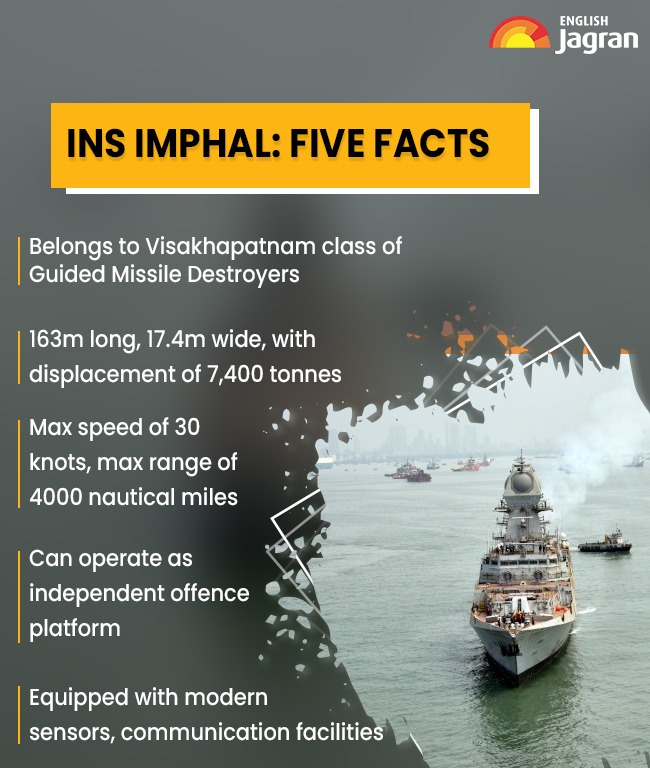- By Akanksha Verma
- Tue, 26 Dec 2023 02:36 PM (IST)
- Source:JND
The Indian Navy inducted its latest stealth-guided missile destroyer, INS Imphal, on December 26. The warship is third of the four vessels which form the Visakhapatnam class of destroyers being built under Project 15B. The ships are categorised under different classes based on their weight, usage, capabilities and weaponry. Visakhapatnam class is the third and latest in the lineage of India's indigenous destroyers. It was preceded by Delhi and Kolkata classes of missile destroyers, built under Project 15 and Project 15A.
Commissioning INS Imphal, Navy chief Admiral R Hari Kumar said, "INS Imphal will not only tackle physical threats that emanate at or from the seas, but more importantly, through the demonstrated strength of an integrated Bharat, she will deter nefarious designs, trying to subvert our national unity...Even as we speak, we have four destroyers of 15 Alpha and Bravo class deployed to counter piracy and drone attacks on merchant shipping." Union Defence Minister Rajnath Singh and Maharashtra Chief Minister Ekanth Shinde were present on the occasion.
#WATCH | Mumbai: Indian Navy's commission of stealth guided missile destroyer 'Imphal' at Naval Dockyard.
— ANI (@ANI) December 26, 2023
Defence Minister Rajnath Singh and Maharashtra CM Ekanth Shinde present on the occasion. https://t.co/vrNL26Gctg pic.twitter.com/fLU8AEaEoL
Designed by Warship Design Bureau, the ship has been built by Mazagon Dock Shipbuilders Limited (MDSL) in Mumbai. MDSL, a Defence Public Sector Undertaking (PSU), has built all the warships under the three projects.
ALSO READ: Navy Deploys Guided Missile Destroyers INS Mormugao, Kochi And Kolkata In Arabian Sea
Here are some of the key facts about India's latest indigenously-built missile destroyer, INS Imphal:
1. INS Imphal gets its name from the capital city of Manipur and has been thus named to represent one of the four corners of India. The other three Indian Navy warships under Project 15B have been named Visakhapatnam, Mormugao and Surat. INS Visakhapatnam is the lead ship among the four and hence the entire class has been named after it.
2. Visakhapatnam class, to which INS Imphal belongs, is the youngest among the three classes of indigenous destroyers. Earlier, the Indian Navy commissioned INS Kolkata, INS Kochi and INS Chennai between 2014 and 2016 under Project 15A, while INS Delhi, INS Mysore and INS Mumbai were inducted between 1997 and 2001 under Project 15.
3. The contract for Project 15B was signed in January 2011. The first ship under this project, INS Visakhapatnam (Pennant No D66), was inducted into the Navy in November 2021. The next year in December the Indian Navy commissioned INS Mormugao (D67) into its fleet. INS Imphal (Pennant D68) is the third ship under this project while the fourth will be named INS Surat (D69) once it has been commissioned.

4. INS Imphal's keel laying ceremony, the first stage in the life of a ship, was held on May 17, 2017. Keel laying marks the laying the foundation of a ship. Previously done by laying one central timber, now modular parts of the ship are placed in the dock. Imphal was launched into the water on April 20, 2019, and set out for maiden trials in April 2023. After completing trials in the harbour and at sea, the warship was delivered on October 20. INS Imphal has been built and undergone trails in record time, shortest for any indigenous missile destroyer, according to the Ministry of Defence.
5. The dimensions of the four vessels belonging to this class measure 163 meters in length and 17.4 meters in width, with a displacement of 7,400 tonnes. The ships in this class employ a 'combined gas and gas' (COGAG) configuration, integrating four gas turbines. This propulsion system enables the vessels to achieve a maximum speed of 30 knots and cover a maximum range of 4,000 nautical miles.
6. A total of 350 crew members operate the ships of Visakhapatnam class. These include 50 officers and 250 sailors.
7. Ensuring increased survivability and reliability in extreme operational and conflict scenarios, the Visakhapatnam-class destroyers boast multiple fire zones, sophisticated battle damage control systems, and distributional power systems. The class is also equipped with a total atmospheric control system (TACS) that shields the crew from chemical, biological, and nuclear threats.
8. A state-of-the-art combat management system uses analytical tools to assess threats and generate a tactical picture of available onboard resources. This capability aids in resource allocation based on the compiled tactical picture and the weapons package at hand. Additionally, the class features a secure network to manage data from all sensors and weapons systems.
9. The arsenal of the Visakhapatnam class includes BrahMos surface-to-surface cruise missiles and vertically launched Barak-8 surface-to-air missiles for engaging shore and sea-based targets at long ranges. Positioned on the forward bow deck is a 127 mm main gun, along with four AK-630 30mm guns for close-point engagement.
10. Anti-submarine warfare capabilities are provided through indigenously developed 533 mm torpedo launchers and RBU-6000 anti-submarine rocket launchers. The vessels have the capacity to operate two multi-role helicopters -- the Sea King or HAL Dhruv. The ship also has rail-less helicopter traversing and hangar facility.

